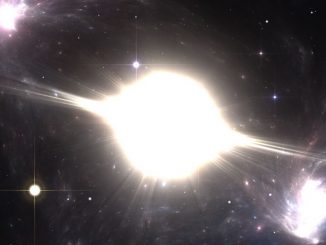
Looking at cosmic microwave radiation, modern satellite observatories like COBE, WMAP and Planck have gradually refined our understanding of the composition of the universe, and the most recent measurements suggest it consists of 4.9 percent ‘normal’ matter (i.e., the matter that makes up stars, planets, gas and dust), or ‘baryons,’ whereas 26.8 percent is the mysterious and unseen ‘dark’ matter, and 68.3 percent is the even more mysterious ‘dark energy.’
Complementing these missions, ground-based observatories have mapped the positions of galaxies and, indirectly, their associated dark matter over large volumes, showing that they are located in filaments that make up a ‘cosmic web.’ Haider and his team investigated this in more detail, using data from the Illustris project, a large computer simulation of the evolution and formation of galaxies, to measure the mass and volume of these filaments and the galaxies within them.
Illustris simulates a cube of space in the universe, measuring some 350 million light-years on each side. It starts when the universe was just 12 million years old, a small fraction of its current age, and tracks how gravity and the flow of matter changes the structure of the cosmos up to the present day. The simulation deals with both normal and dark matter, with the most important effect being the gravitational pull of the dark matter.
When the scientists looked at the data, they found that about 50 percent of the total mass of the universe is in the places where galaxies reside, compressed into a volume of 0.2 percent of the universe we see, and a further 44 percent is in the enveloping filaments. Just 6 percent is located in the voids, which make up 80 percent of the volume.
But Haider’s team also found that a surprising fraction of normal matter — 20 percent — is likely to have been transported into the voids. The culprit appears to be the supermassive black holes found in the centres of galaxies. Some of the matter falling towards the holes is converted into energy. This energy is delivered to the surrounding gas, and leads to large outflows of matter, which stretch for hundreds of thousands of light-years from the black holes, reaching far beyond the extent of their host galaxies.
Apart from filling the voids with more matter than thought, the result might help explain the missing baryon problem, where astronomers do not see the amount of normal matter predicted by their models.
Dr. Haider comments: “This simulation, one of the most sophisticated ever run, suggests that the black holes at the centre of every galaxy are helping to send matter into the loneliest places in the universe. What we want to do now is refine our model, and confirm these initial findings.”
Illustris is now running new simulations, and results from these should be available in a few months, with the researchers keen to see whether for example their understanding of black hole output is right. Whatever the outcome, it will be hard to see the matter in the voids, as this is likely to be very tenuous, and too cool to emit the X-rays that would make it detectable by satellites.



